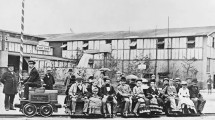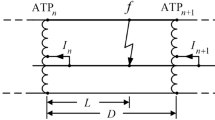Abstract
There are numerous uncovered long-distance overhead cables in the distribution network system which can be inappropriate in densely populated urban. Therefore, in most countries, the Electric Power Corporations (EPCO) are attempting to find a solution to replace the uncovered overhead lines with covered one. Since, these replacements are not economic, some corporations constructing a covering apparatus for insulating electrical distribution lines. This paper proposes a first and novel prototype robot for on-line insulating overhead robot. The suggested tele-operated mobile wrapped insulator cover on overhead cables without any experience of a skilled technician. The experiment results demonstrated that the proposed mechanism is an appropriate methodology for insulating of the bare wire. In future, by developing the robot, EPCOs will utilize it on live high voltage line to (1) reduce the power outage, as well as operation and maintenance costs, (2) save resources and time, (3) prevent the electrical interruptions caused by contacting trees and animals with overhead lines and (4) increase the power network reliability, significantly.












Similar content being viewed by others
References
Andersson, G., et al.: Causes of the 2003 major grid blackouts in North America and Europe, and recommended means to improve system dynamic performance. IEEE Trans Power Syst 20, 1922–1928 (2005)
Boddingtons Electrical co., Bodtect overhead line shrouding. http://www.boddingtons-electrical.com/bodtect-overhead-line-shrouding (2018)
Debenest, P., Guarnieri, M., Takita, K., Fukushima, E. F., Hirose, S., Tamura, K., Kimura, A., Kubokawa, H., Iwama, N., Shiga, F.: Expliner - robot for inspection of transmission lines. In: Proceedings of the IEEE International Conference on Robotics and Automation, pp. 3978–3984. IEEE, Pasadena, CA (2008)
Debenest, P., et al.: Expliner-toward a practical robot for inspection of high-voltage lines. Field Ser Robot 62, 45–55 (2010)
Fonseca, A., Abdo, R., Alberto, J.: Robot for inspection of transmission lines. In: Proceedings of the 2nd International Conference on Applied Robotics for the Power Industry, pp. 83–87 (2012)
Han, S., Hao, R., Lee, J.: Inspection of insulators on high-voltage power transmission lines. IEEE Trans Power Deliv 24, 2319–2327 (2009)
Ishino, R., Tsutsumi, F.: Detection system of damaged cables using video obtained from an aerial inspection of transmission lines. IEEE Power Eng Soc Gen Meet 2, 1857–1862 (2004)
Jin, J., Zhu, H., Zhang, G.: Counterweight- navigation of a mobile inspection robot working on the ground wires. In: Proceedings of the IEEE International Conference on Automation and Logistics, pp. 278–282 (2009)
Li, Z., Ruan, Y.: Autonomous inspection robot for power transmission lines maintenance while operating on the overhead ground wires. Int J Adv Robot Syst 7, 111–116 (2010)
Lugschitz, H.: Overhead lines and underground cables. In: Papailiou, K. (ed.) Overhead Lines. CIGRE Green Books, Springer, Cham (2017)
Montambault, S., Pouliot, N.: Design and validation of a mobile robot for power line inspection and maintenance. Field Serv Robot 42, 495–504 (2008)
Navrud, S., Ready, R.C., Magnussen, K., Bergland, O.: Valuing the social benefits of avoiding landscape degradation from overhead power transmission lines: do underground cables pass the benefit–cost test. Landsc Res 33, 281–296 (2008)
Norges Vassdrags og Enegidirektorat (NVE).: Kabel som alternativ to luftledning [Cable as an Alternative to Overhead Lines], KTE notat nr. 42/03. Norges Vassdrags og Enegidirektorat, Oslo (2003). (Revised 2004)
Park, J.Y., Lee, J.K., Cho, B.H., Oh, K.Y.: An inspection robot for live-line suspension insulator Strings in 345-kV power lines. IEEE Trans Power Deliv 27, 632–639 (2012)
Phillips, A., et al.: Autonomous overhead transmission line inspection robot (TI) development and demonstration. In: Proceedings of the 2nd International Conference on Applied Robotics for the Power Industry, pp. 94–95 (2012)
Sawada, J., Kusumoto, K., Munakata, T., Maikawa, Y., Ishikawa, Y.: A mobile robot for inspection of power transmission lines. IEEE Trans Power Deliv 6, 309–315 (1991)
Seok, K.H., Kim, Y.S.: A state of the art of power transmission line maintenance robots. J Electr Eng Technol 11, 1412–1422 (2016)
Shahnia, F., et al.: Insulation effects and characteristics of XLPE covered overhead conductors in low and medium voltage power distribution systems in Iran. In: Conference Record of the 2006 IEEE International Symposium on Electrical Insulation, pp. 11–14 (2006)
Suzhou Volsun Electronics technology co. Ltd: Silicone rubber overhead line cover used on power substation. http://www.szvolsun.com/News/Technical-Knowledge/show_47.html (2015)
Thayer, E.S.: Computing tensions in transmission lines. Electrical World Magazine, pp. 72–73 (1924)
Tziouvaras, D.A.: Protection of high-voltage AC cables. Power Syst Conf Adv Metering Prot Control Commun Distrib Resour PS’06, 316–328 (2006)
Yotsugi, A. et al.: Electrical wire insulating cover, U.S. Patent 466.128 (1974)
Author information
Authors and Affiliations
Corresponding author
Appendices
Appendix A
There is a simple relation between the travelling and wrapping velocity to cover a cable as follows
where OL is the overlap length coefficient and W is width of tape (Fig. 13). The parameters \( \dot{\varphi } \) and \( \dot{\theta } \) are the angular velocity of the DC motor of the travelling unit and wrapping unit, respectively. See Fig. 13. The \( d_{1} \), \( d_{2} \) and \( d_{3} \) are 60, 150 and 70 mm, respectively. Moreover, the W and OL are investigated 20 mm and 10%, respectively.
Appendix B
2.1 Control system design
Since a cable is a flexible object with uniform weight per unit length, it in a single span of a transmission line can be described by a set of hyperbolic functions which describe catenary curves (Thayer 1924). Therefore, the constant speed DC motor controller is designed for controlling two wrapping and travelling speed on the cable. In this robot a cascade controller is employed. Figure 14 shows the structure of the proposed cascade controller. The overall control scheme is composed of two main blocks: (1) a serial PI-based velocity control loop that provides a reference command current and (2) a serial PI-based current control loop generating the reference voltage.
Figure 15 indicates the overall structure of the current loop. The open-loop transfer function of the current controller is obtained as
The back electromotive force (back EMF), eb, is depending on rotor speed which is a mechanical parameter. Therefore, since the mechanical time constant is much slower than the electrical time constant, the eb is ignored in the transfer function. The \( {\text{K}}_{\text{i}}^{\text{series}} \) is defined as
In other words, the value of the \( {\text{K}}_{\text{i}}^{\text{series}} \) is selected as the zero of a PI controller to neutralize the pole of the transfer function of the current to voltage. This satisfies the stability of the inner current loop and we have a first order transfer function. The \( {\text{K}}_{\text{p}}^{\text{series}} \) is obtained as
Based on the Eqs. 3 and 4 the parameters of the PIs of current loops are determined by the resistance and inductance of the armature coils. To identify these characteristics, a cosine voltage, \( V = 100 \cos (100 \times t) \), is applied to DC motors. In this case, the DC motor does not move (\( e_{b} = 0 \)). Now, the current and voltage of motor terminal are measured. The measured voltage is defined as
The transfer function of current to voltage can be defined as
Therefore, the measured current can be obtained as
where the magnitude an phase of the transfer function is defined as
By rewriting Eq. (5), we have
Now we define
We have
By multiplying both sides of Eq. (12) by \( \cos \left( {\omega_{0} t} \right) \) and integrate from 0 to T, we have
Moreover, by multiplying both sides of Eq. (12) by \( \sin \left( {\omega_{0} t} \right) \) and integrate from 0 to T, we have
Based on Eqs. (11), (13) and (14) we have
where T is the overall time of the applying voltage to identify characteristics of the motor. Now, by expanding Eq. (7), we have
we have
Therefore,
By multiplying both sides of Eq. (19) by \( \cos \left( {\omega_{0} t} \right) \) and \( \sin \left( {\omega_{0} t} \right) \) and integrate from 0 to \( T \), we have
According to Eqs. (18), (20) and (21) we have
By Considering Eq. (8) and dividing Eq. (22) on Eq. (15), we have
where \( \frac{T}{2}d \), \( \frac{T}{2}c \), \( \frac{T}{2}b \) and \( \frac{T}{2}a \) are known, we can define
Therefore, we have
Based on Eqs. (9) and (16), the Eq. (23) can be rewritten as
where \( \frac{T}{2}d \), \( \frac{T}{2}c \), \( \frac{T}{2}b \) and \( \frac{T}{2}a \) are known, we have
We can rewrite Eq. (27) as
By substituting Eq. (29) on Eq. (26), the resistance of rotor coil is obtained. Finally, the inductance of the coils is calculated as
Therefore, by Eqs. (26) and (30), the resistance and inductance of the coil are identified, respectively. The sufficient bandwidth of the current-loop is assigned 1 kHz. Now, the Eqs. (3) and (4) are utilized to compute \( {\text{K}}_{\text{i}}^{\text{series}} \) and \( {\text{K}}_{\text{p}}^{\text{series}} \), respectively. Up to now, the resistance and inductance of the coil are identified. The parameters of the PIs for velocity loops were selected by trial and error.
To consider the ability of the proposed cascade controller, we supposed that the reference angular velocity of the DC motor in travelling unit, \( \dot{\varphi } \), is 0.1 rpm. According to Eq. (1), reference angular velocity of the DC motor in wrapping unit, \( \dot{\theta } \), is equal to 54 rpm. Figure 16 shows the actual and reference speeds of two DC motors. In the first test, the robot moves with the specified speed when there is not any obstacle on the cable (Fig. 16a, b) as well as moves with the specified speed in order to pass over the obstacles (Fig. 16c). The experimental results have shown the robust performance of the suggested cascade controller scheme and have and put into evidence the ability of the mentioned controller in the our proposed robot.
Rights and permissions
About this article
Cite this article
Kalani, H., Malayjerdi, M. & Hasanpour Dehnavi, M. H2M robot: a new prototype robot for insulation of high voltage transmission. Int J Intell Robot Appl 3, 87–98 (2019). https://doi.org/10.1007/s41315-018-0066-6
Received:
Accepted:
Published:
Issue Date:
DOI: https://doi.org/10.1007/s41315-018-0066-6








